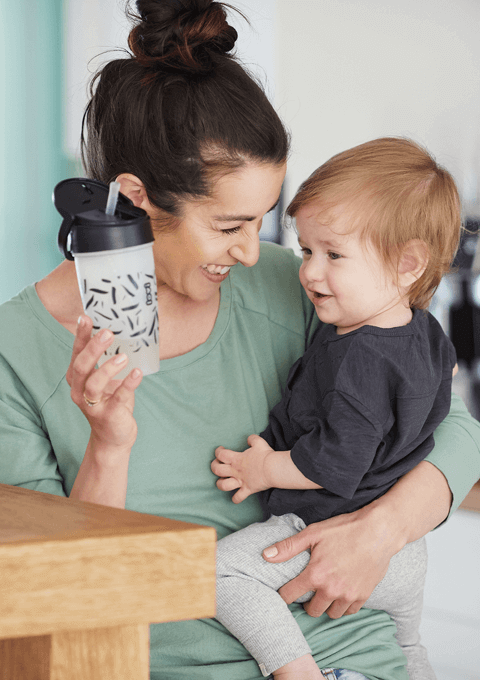It is convenient to let your child drink from a bottle, but in the long run, it is not recommended. The 10-month-old infant should already learn other ways to quench thirst, and using a cup with a straw is not only safe but also valuable for its development. Discover the proven benefits of drinking through a straw.
The ability to suckle arises already at the stage of foetal life. After birth, a healthy newborn can satisfy its hunger. Sucking is also a training for the baby's mouth – the baby exercises lips, tongue and facial muscles. All this so that it can cope with solid foods at the next stage of development. These exercises also help your baby coordinate eating with breathing and prepare your baby to speak.
Over time, the sucking reflex disappears, and the baby is ready for new challenges. By around the sixth month, you should have already tried spoon-feeding. The next months are a time for training drinking from cups. When your baby is 8-10 months old, it is worth to start to teach it to drink from a cup with a straw. Remember to give your child time. Let your baby master one skill before moving on to the next.
Drinking through a straw can have a beneficial effect on your child's development if you follow certain rules.
Remember:
When drinking through a straw, lips should be involved, and the child should not hold the straw with its teeth. At some stage of development, sticking to the sucking may have an adverse effect on the child's teeth and oral cavity formation. At the same time, proper drinking from a cup with a straw does not cause the risk of malocclusion.
One of the essential skills for eating, drinking and speaking is proper breathing. The baby must also master the coordination of swallowing food with the intake of air. Thanks to drinking through a straw, the infant develops one of the extremely important skills – controlling the phase of inspiration and expiration, and this significantly reduces the risk of choking while drinking and eating.
Exercising facial muscles, mouth, proper breathing, and good bite affects the child’s speech development. When drinking through a straw, the infant must engage the lips, tongue, cheeks that is the entire speech apparatus. Such training will be invaluable when the baby starts to talk. All the skills it practices while drinking afterwards will help to articulate sounds.
Remember: Specialists recommend giving your baby water. However, if you want to make your baby to work harder while drinking, from time to time, you can give your baby as a snack, a cocktail or a smoothie made of fresh vegetables and fruits.
Children usually love drinking through a straw from their favourite cup. It's a lot of fun, and it's a new skill that gives them a sense of pride. The cup with a straw can be taken anywhere, and when it has a tight seal, you can be calm that nothing will spill out.
A cup with a straw gives your child a sense of independence. Once your child has mastered drinking from a cup with a straw, it can quench thirst at any time, and this is a big step towards being independent. The infant has reason to be proud and happy, and each such achievement strengthens its self-esteem. Drinking from a cup with a straw teaches the child self-control because the infant drinks whenever it wants and as much as it wants.
At a certain stage of the child's development, the sucking reflex disappears, and for a proper, harmonious development it is necessary to switch to other ways of drinking and feeding. A cup with a straw is a good choice when the child is 8-10 months old. It allows the child to train mouth and face muscles and prepares for further challenges such as speaking. It does not cause malocclusion and helps the infant to go to the next stages of independence.
The extent and range of progress achieved by your baby during his first years is incredible. From a tiny, lying mite who does not yet know where his nose is, to a quite smart toddler who has a lot to say on any subject, climbs ...
When and how should you start baby's drinking training? This is a very individual issue. There are children who will grab a cup early to mimic adults, and quickly learn how to drink from it
There comes a moment when mum's breast alone is not enough. Here you can find tips when and how you should introduce new components into your baby's diet.
Gums hygiene, and later care for baby's milk teeth, influence the development of speech and occlusion, as well as a general condition of his tiny body. Correct oral hygiene will help to avoid dental problems now and in the ...
There are times when your baby will not fall asleep for hours, and then will wake up in the middle of the night and start his day at three in the morning. You are wasted, feel helpless and at the end of your tether. We cannot ...
Baby’s cry can be really stressful for young parents. Especially, when a baby is difficult to comfort and cries for a long period of time. In this situation a baby may have colic.
